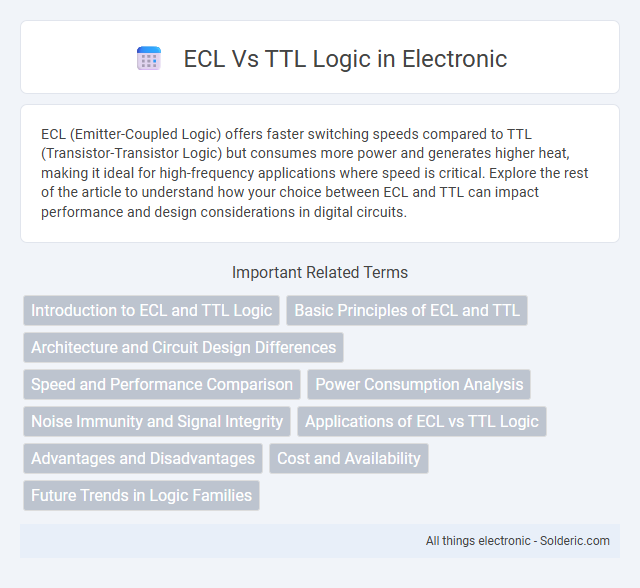ECL (Emitter-Coupled Logic) offers faster switching speeds compared to TTL (Transistor-Transistor Logic) but consumes more power and generates higher heat, making it ideal for high-frequency applications where speed is critical. Explore the rest of the article to understand how your choice between ECL and TTL can impact performance and design considerations in digital circuits.
Comparison Table
| Feature | ECL (Emitter Coupled Logic) | TTL (Transistor Transistor Logic) |
|---|---|---|
| Operating Speed | Fastest among logic families, typically up to GHz range | Slower, usually up to tens of MHz |
| Power Consumption | High power consumption, continuous current flow | Moderate to low power consumption |
| Voltage Levels | Low voltage swing (~0.8V) | Standard logic levels (0V-5V) |
| Noise Margin | Lower noise margin (~0.3V) | Higher noise margin (~0.8V) |
| Output Type | Open emitter outputs, differential | To ground or +5V, single-ended |
| Applications | High-speed applications, telecommunications, supercomputers | General-purpose digital circuits, microcontrollers |
| Complexity | More complex, requires matched components | Simple design and implementation |
| Cost | Higher cost | Lower cost |
Introduction to ECL and TTL Logic
ECL (Emitter Coupled Logic) and TTL (Transistor-Transistor Logic) represent two fundamental digital logic families used in electronic circuits. ECL is known for its high-speed switching capabilities achieved through differential amplifier configurations, operating with a constant current to minimize transistor saturation delay. TTL, on the other hand, relies on bipolar junction transistors and benefits from simpler design and lower power consumption, making it widely used in general-purpose digital applications.
Basic Principles of ECL and TTL
Emitter-Coupled Logic (ECL) operates using differential amplifier pairs that switch transistors in a non-saturation region, enabling ultra-fast switching speeds and low propagation delay. Transistor-Transistor Logic (TTL) relies on multi-stage transistor switching where transistors saturate and cut off, providing robust noise margins but higher power consumption and slower speed compared to ECL. ECL's continuous current flow contrasts with TTL's switching current pulses, making ECL suitable for high-frequency applications requiring minimal delay.
Architecture and Circuit Design Differences
ECL (Emitter-Coupled Logic) utilizes differential amplifier stages to achieve ultra-high-speed switching, relying on a constant current source to minimize voltage swings and reduce propagation delay. TTL (Transistor-Transistor Logic) employs multi-emitter bipolar junction transistors and uses transistor switching with higher voltage swings, resulting in slower speed but simpler circuit design. The architecture of ECL favors speed through differential pairs and current steering, while TTL prioritizes noise immunity and ease of integration with transistor switch configurations.
Speed and Performance Comparison
ECL (Emitter-Coupled Logic) offers significantly higher speed compared to TTL (Transistor-Transistor Logic), with propagation delays typically around 0.5 nanoseconds versus TTL's 10-20 nanoseconds. This speed advantage in ECL results from its differential transistor pair design, which avoids transistor saturation and enables faster switching times. ECL's superior performance makes it ideal for high-frequency applications such as telecommunications and advanced computing systems where timing precision is critical.
Power Consumption Analysis
ECL (Emitter-Coupled Logic) consumes significantly more power than TTL (Transistor-Transistor Logic) due to its continuous current flow, with ECL circuits typically drawing constant power regardless of switching activity. TTL devices exhibit lower power consumption by switching between saturation and cutoff states, minimizing current flow except during transitions. Your choice between ECL and TTL logic should consider power efficiency requirements alongside speed and noise immunity characteristics.
Noise Immunity and Signal Integrity
Emitter-Coupled Logic (ECL) offers superior noise immunity compared to Transistor-Transistor Logic (TTL) due to its differential signaling and constant current operation, which reduces voltage swings and susceptibility to noise. ECL maintains excellent signal integrity at high frequencies by minimizing propagation delay and reducing ground bounce, whereas TTL circuits are more prone to signal distortion and voltage level fluctuations under fast switching conditions. For your high-speed and noise-sensitive applications, choosing ECL ensures more reliable data transmission and better performance in electrically noisy environments.
Applications of ECL vs TTL Logic
ECL (Emitter-Coupled Logic) is favored in high-speed applications such as telecommunications, radar systems, and high-frequency data processing due to its fast switching speeds and low propagation delay. TTL (Transistor-Transistor Logic) is widely used in general-purpose digital circuits, microcontrollers, and interfacing applications where moderate speed and power efficiency are sufficient. The choice between ECL and TTL depends on the requirement for speed versus power consumption and noise immunity in the specific application.
Advantages and Disadvantages
Emitter-Coupled Logic (ECL) offers high-speed switching capabilities with propagation delays typically in the picosecond range, making it ideal for high-frequency applications. However, ECL consumes significantly more power and generates greater heat compared to Transistor-Transistor Logic (TTL), which has moderate speed and lower power consumption, suitable for general-purpose digital circuits. TTL circuits provide simpler design and robust noise margins but exhibit slower switching speeds and higher propagation delays relative to ECL.
Cost and Availability
ECL (Emitter Coupled Logic) circuits generally have higher costs due to their complex design and specialized fabrication processes, limiting their widespread availability compared to TTL (Transistor-Transistor Logic) components. TTL logic devices benefit from mass production and mature technology, resulting in lower prices and broader availability across various suppliers. Cost efficiency and accessibility make TTL the preferred choice for most standard digital integrated circuit applications.
Future Trends in Logic Families
ECL (Emitter-Coupled Logic) continues to be favored for ultra-high-speed applications due to its rapid switching capabilities and low propagation delay, making it critical in advanced communication systems and high-frequency trading platforms. TTL (Transistor-Transistor Logic) is gradually being supplanted by CMOS technology, which offers lower power consumption and higher integration density, driving future trends toward energy-efficient and scalable digital circuits. Emerging logic families integrate the speed advantages of ECL with the low power and scalability of CMOS, exemplified by technologies like BiCMOS and SiGe, which are poised to dominate next-generation high-performance computing and telecommunications.
ECL vs TTL logic Infographic

 solderic.com
solderic.com